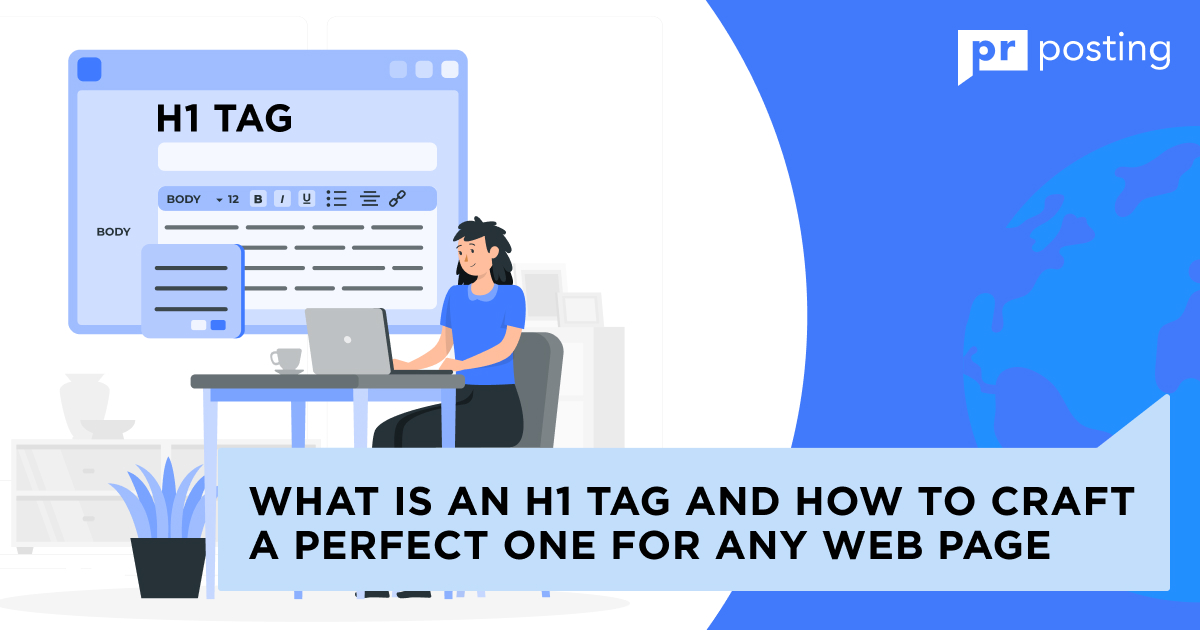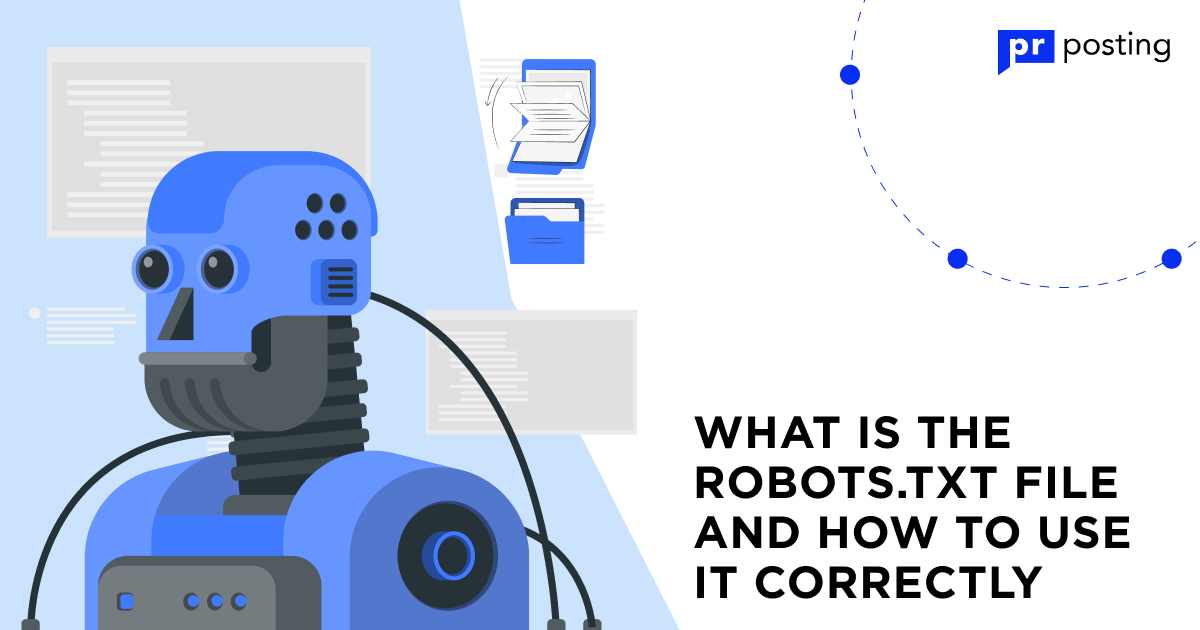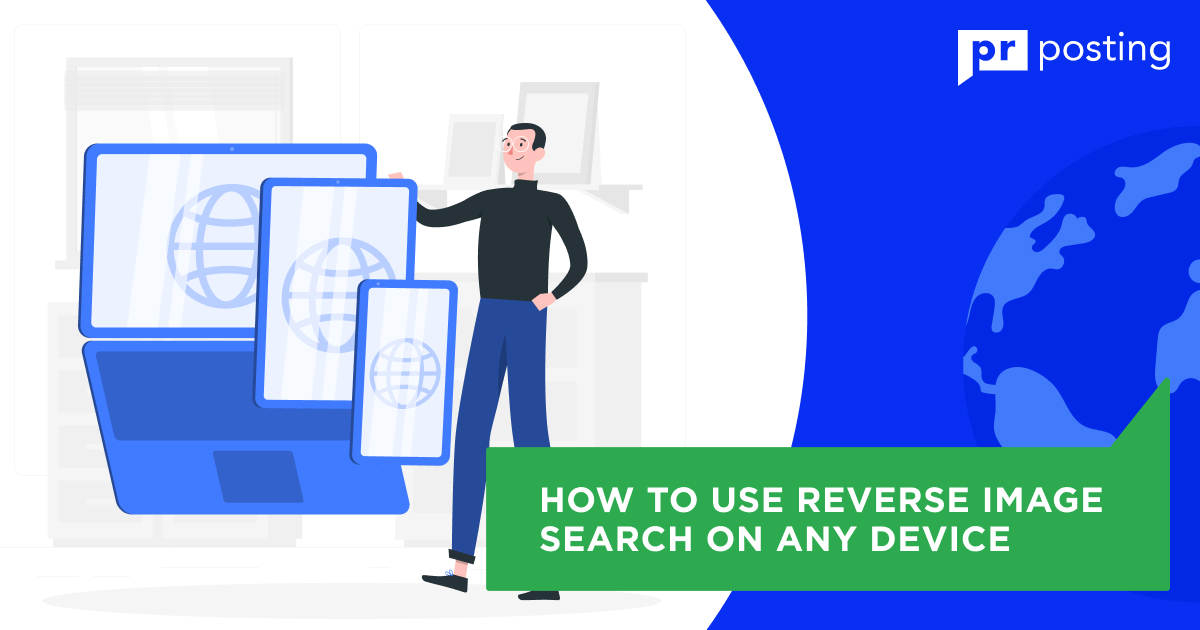What Is An H1 Tag And How To Use It Correctly

What Is an H1 Tag
H1 is the top-level heading. It is used in HTML code to indicate the title of the page. As a rule, it is highlighted with the help of size, font, or color using CSS or other markup tools.
The H1 tag fits into the HTML code of the page. It has an opening <h1> and a closing </h1>. It can be compared to the title of a text document, book, or advertising brochure. To simplify navigation, such a code element is used at the very beginning of the visible part of the page.
Example: The H1 tag of this page highlights the heading “What is the H1 tag and how to use it correctly.”
H1 Header vs. Page Title
Users see the main title immediately after opening the site. It is written in the <body> section, so it is displayed on the device screen. Its value for technical optimization is relatively low. However, this tag often defines user behavior. It affects how quickly visitors will find the information they need and how many of them will simply close the tab in the browser. Given that search engines pay attention to UX and bounce rates, the title still matters for page ranking.
The title of the page is specified by the <title> tag, which is contained in the <head> section. It is not displayed in the main window of the website but is used on the search results page and in the browser tab. Crawlers use this tag to collect information about the page. It has a greater impact on optimization performance compared to the title but is hardly used for navigation and does not determine user behavior.
So, H1 is needed first for visitors and only then for search engines. The title is the opposite.
Why Are H1 Tags Important for SEO?
One of the leading developers of the Google search engine, John Muller, explained that the system carefully studies both keywords and the context of their use. He emphasized the special importance of page titles, which are denoted by H tags with numbers from 1 to 6. Let’s see how exactly they affect the site ranking.
They Help Search Engines Understand Page Content
The H1 header tells the crawler: “Look, this is what will happen next.” If it contains a correctly entered key phrase, the system will associate the site with a certain topic. Therefore, the page rank will increase even for related queries. Although optimizing the H1 tag is not as important as working with the Title, it can also be an essential promotion tool.
They Improve User Experience
The text marked with the H1 tag will be the first to be seen by site visitors. They will be able to immediately determine whether the page corresponds to their request. If you could engage the user with the headline, conversions will significantly increase, and commercial performance will improve.
Another advantage of the H1 heading is content structuring. Research shows that structured text with headings, lists, and other markup elements is read 33% faster and remembered 50% better. If you want your offer to be recalled even after closing the tab, the page must be structured.
They Ensure Better Accessibility
Tens of millions of Internet users have serious vision problems. They use voicing tools to consume large volumes of textual content. According to the results of surveys, 60% of them focus on the H1 heading. If the information in it does not meet expectations, users close the page. Therefore, poor optimization of this element can deprive you of a large part of your potential audience.
How Do I Add an H1 Heading
The procedure is simple. Even if you are taking your first steps in learning HTML and CSS, it will take a few seconds to get the header right. Also, most content management systems automate this process — you just need to click one button or use a ready-made template.
In HTML
Find the <body> section where the visible part of the site is assembled. Insert a heading before the main text content and separate it with <h1></h1> tags.
Example:
<h1>This is a visible header example</h1>
Your text here
<h2>First text section</h2>…
On WordPress
Most themes in this CMS already have H1 headings. If you mistakenly deleted or changed the necessary item, it can be easily restored:
- Create a new text block and enter the required data.
- Select the text — a context menu will appear above it.
- Click on the button with the paragraph icon —”¶” (Pilcrow).
- Select “Transform to a heading.”
- By default, the system will select the H2 subheading, which will be specified in the context menu.
- Click on the “H2” button.
- Select H1 from the drop-down list.
In Wix
As in other content management systems, the title of the page or post automatically becomes the main title. If you want to change it, use simple instructions:
- Create a text block.
- Select it — a toolbar will appear on top.
- Click the “Edit Text” button.
- Click the down arrow button next to “Themes.”
- Select “Heading 1.”
In SquareSpace
In most themes, it is enough to fill in the standard field, “Enter your title here.” However, you can create the required header manually:
- Create a text block.
- Hover the cursor over it and click to enter editing mode.
- A toolbar will appear at the top — select the “Paragraph” menu from it.
- Select “Heading 1” from the drop-down list.
How to Write Good H1 Tags for SEO
The main rule is that titles should be short but comprehensive. Describe in them the essence of the content on the page and give the reader motivation to read it. But try to avoid outright clickbait and lies — search engines can ban you because of user complaints and a high bounce rate. We will also share additional tips on optimizing H1 tag in SEO.
Use Only One H1 Tag per Page
Remember how book chapters and journal articles are organized. One section is one topic and one title. Such a decision creates the right structure and hierarchy. It will also be relevant for websites that need to present information concisely, interestingly, and efficiently.
If you add multiple headings with an H1 tag, it means that the page contains multiple separate topics. Most readers will negatively perceive this because they came to your site with a specific goal and do not want to receive additional information from another industry.
The creation of several main headings harms technical optimization as well. For example, Google sees this as poor structuring and negative UX. As a result, the site ranking in search results decreases even with the ideal state of other SEO elements.
Your H1 Should Describe the Topic of Your Page
The heading is the primary navigation tool. After clicking on an attractive link in the search engine, the user should receive comprehensive information about what awaits them on this page. Try to describe all the content you offer your visitors as briefly as possible.
Example:
- 60 ways to cook salmon.
- A short guide to SEO optimization.
- Drones: what they are, why they are needed, and how to control them.
And another advice that we will keep repeating: write truthfully, and do not mislead the user. An blatant lie will increase the bounce rate and draw the attention of search crawlers to the inconsistency of the text and title. The outcome can be any, from a downgrade to a complete ban.
And don’t promise more than you can deliver. Clickbait headlines like “Uncovering the Secret of Billionaire Success” grab attention at first but then become annoying and disappointing. As a result, the visitor will feel worse about the entire site, even if they were only upset by the guest blog post.
Include Your Target Keyword
Search engine optimization cannot be based on just one H1. However, a well-crafted headline can reinforce an existing strategy and improve rankings. Therefore, it is worth using the most frequent keyword in the first part of the text content.
Examples of H1 tags optimized for the search engine:
- Cars in Detroit: buy, sell, trade.
- How to cook venison: 20 exclusive recipes.
- Learn HTML in 3 days: a short course for beginners.
Use the first keyword selected using special tools. But only one — spamming and repetition will automatically lower your rating. Additionally, it will be difficult for you to fit so much information into a short text fragment.
Answer User Intent with Your H1
Google tries to optimize its search engine precisely according to the wishes and expectations of the user rather than according to crawlers’ algorithms. That is why the company is investing billions of dollars in developing artificial intelligence, trying to reproduce the way humans think.
You should also consider user intents before creating the main page title. They can be conditionally divided into four types:
- Transactional. They call for specific action. For example, “Buy a washing machine in London cheap.” Suitable for commercial pages — online store catalogs or landing pages. If it is not possible to place an order on a site with such H1, the user will be disappointed.
- Commercial. They invite you to compare or study the product. For example, “Which smartphone in 2023 is better: Samsung or Apple?” Suitable for blog posts, analytical articles, and reviews.
- Informational. They invite you to familiarize yourself with certain data. For example, “A Quick Guide to PPC: The Secrets of Successful Advertising.” It is suitable for guides, e-tutorials, and how-to articles.
- Navigational. They invite you to learn more about a brand, company, or person. For example, “Warren Buffett: Who is he and what does he do?” or “Toyota — a symbol of reliability or gray mediocrity?” Suitable for brand pages and PR materials.
Make Sure That Your H1 Tag Is Visible
Some content management systems hide the main header or reduce its size to save space on the page. This is a negative practice of using H1 tags in SEO. If the text block is first to catch the visitor’s eye, it is disorienting and makes it difficult to perceive the information.
Additionally, modern search engine algorithms see a hidden header as a sign of poor UX. The rating of such a page immediately decreases — the crawler believes that it will be poorly perceived by users. Therefore, it is very important to preserve the traditional structure of the document not only technically but also visually.
Make Your H1 Tag Stand Out
Use special heading styles. A good practice is to choose a larger font size and a bolder font. You can also try playing around with colors if your theme and page structure allow for it.
The H1 heading should attract more attention than H2 and H3. It should also be highlighted against the background of pictures and other multimedia elements. If the other block has a larger size or a brighter color, the user will judge the page content by it.
Mind the H1 Tag Length
Sixty characters with spaces — it is this number that describes the optimal size of the first and most significant heading. This is enough to describe the topic of the article or commercial offer. And even if you select the largest font, you will have enough space to neatly place all the blocks.
If the H1 tag is longer, the visitor can get tired. They will stop reading without getting the information they need. There is a high probability that after this, the user will impulsively close the tab. Besides, long titles add work to designers. And search engines don’t like them, which can lower the page’s ranking.
But a short title of up to 30 characters with spaces is no better. First, it will be rated low by search engines. Secondly, a small text block will simply get lost on the page, especially if there is a bright image next to it. Thirdly, it will be difficult for you to convey the key points of the article and arouse interest.
The H1 Tag Should Be the Same or Slightly Different from the Page Title
This is logical because you attract the user’s attention to the search results page, and you have to meet their expectations. If the title is very different from the text of the link, it can lead to negative emotions. However, repeating the same phrase twice does not make sense. We have already told what is an H1 tag — it should be more informative than the Title.
Example:
Title — What is content marketing, and how to make it bring a profit?
H1 — Content marketing: the complete guide with success tips.
Use Title Case for H1s
According to good SEO practice, you should start the H1 tag with a word longer than 4 characters and with a capital letter. This way, you will attract more users’ attention in search results and on the main page of your site. At first glance, this decision may seem unimportant, but in practice, it significantly increases the conversion rate. Only small letters are usually used for posts on social networks and forums.
The Most Common Mistakes to Avoid
Experiments by the world’s leading SEO specialists show that markup errors have almost no impact on search engine rankings in the short term. However, a poorly organized page will rank lower over time due to poor UX and visitors who cannot find the information they need.
Missing Tags
Imagine that you visit a site without <h1> tag. The first thing that catches your eye is a block of text, probably with a commercial proposition or description of business benefits. What exactly will you get on this page? To find out, you will have to open one or more pages. Moreover, you may come across a block with additional information that is only indirectly related to the topic. Chances are this scenario will make you want to close the site and never come back.
Do not forget about the main heading — it should attract user attention and give them clear navigation elements.
Duplicate Tags
Note: H1 tag should not repeat H2 or subsequent levels verbatim. This confuses the user and search crawlers. The former cannot decide where exactly they will get the information they need, and the latter reduce the ranking due to keyword spamming and other negative SEO practices.
If you really want to emphasize a certain subheading, expand it with additional words, for example.
H1 — How to make a metal surface shine.
H2 — How to make a metal surface shine with improvised means.
Tags That Are Too Long (or Too Short)
Remember the optimal length of the H1 tag for SEO — from 30 to 60 characters with spaces. Long headlines can tire users and scare off search engines. Short ones visually get lost on a page with a complex structure and bright multimedia elements. Of course, minor violations of this rule are allowed in some cases. However, it is worth objectively evaluating the final appearance of the site and conducting testing with real users.
Multiple Tags
Multiple H1 headings are bad practice. It is difficult for the user to separate the body of the text and perceive the main idea, and crawlers think that this is bad UX. Again, you get a double whammy that can significantly lower your site’s search engine rankings for a few weeks.
The H1 heading is more than just a visual element
Web page markup is a very important part of its optimization. It attracts user attention, facilitates the perception of information and, in the long run, increases the site’s ranking in search results. Knowing what are H1 tags, you can organize the textual content using a classic structure, increasing the conversion rate and improving the commercial performance of the business.
If you are not sure about the correctness of the formation of headings, we advise you to use special diagnostic tools. They are available in SEO dashboards from Moz, Ahrefs, SEMRush, and other digital marketing leaders. Such services detect basic errors and suggest how to correct them. This is especially convenient for beginning developers and webmasters.
FAQ
How Long Should an H1 Tag Be?
30 to 60 characters with spaces. A larger headline will tire the reader, and a smaller one will simply get lost on the page.
Is the H1 Tag the Same as the Page Title?
They should be very similar to meet the visitor’s expectations. But it is better to make H1 more informative to give an idea of the content of the page.
What Is an H1 Tag?
The <h1></h1> markup is used to properly design the main page title. It should briefly and succinctly describe the content on the site.
Why Are H1 Tags Important for SEO?
These elements affect the user experience (UX). Their absence or incorrect use gives search engines a signal about poor technical optimization of the site. This can significantly lower ratings in the long run.
How to Write Good H1 Tags for SEO?
Keep them short but to the point. Include key phrases and consider user intent. Highlight headings visually and start long words with capital letters.







